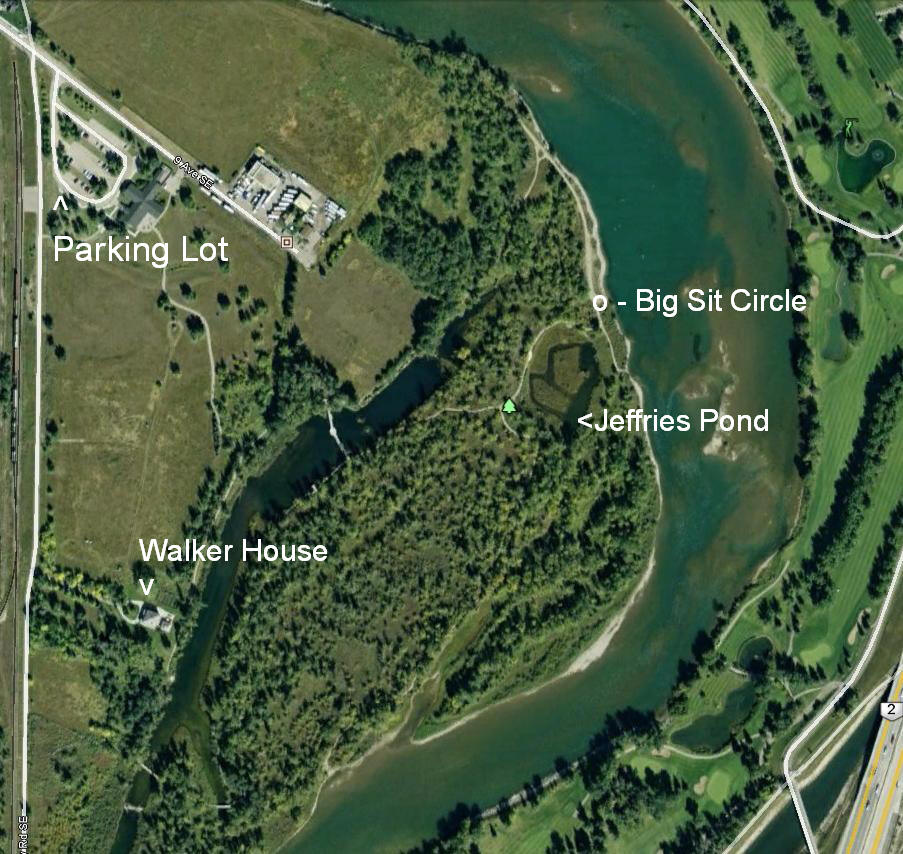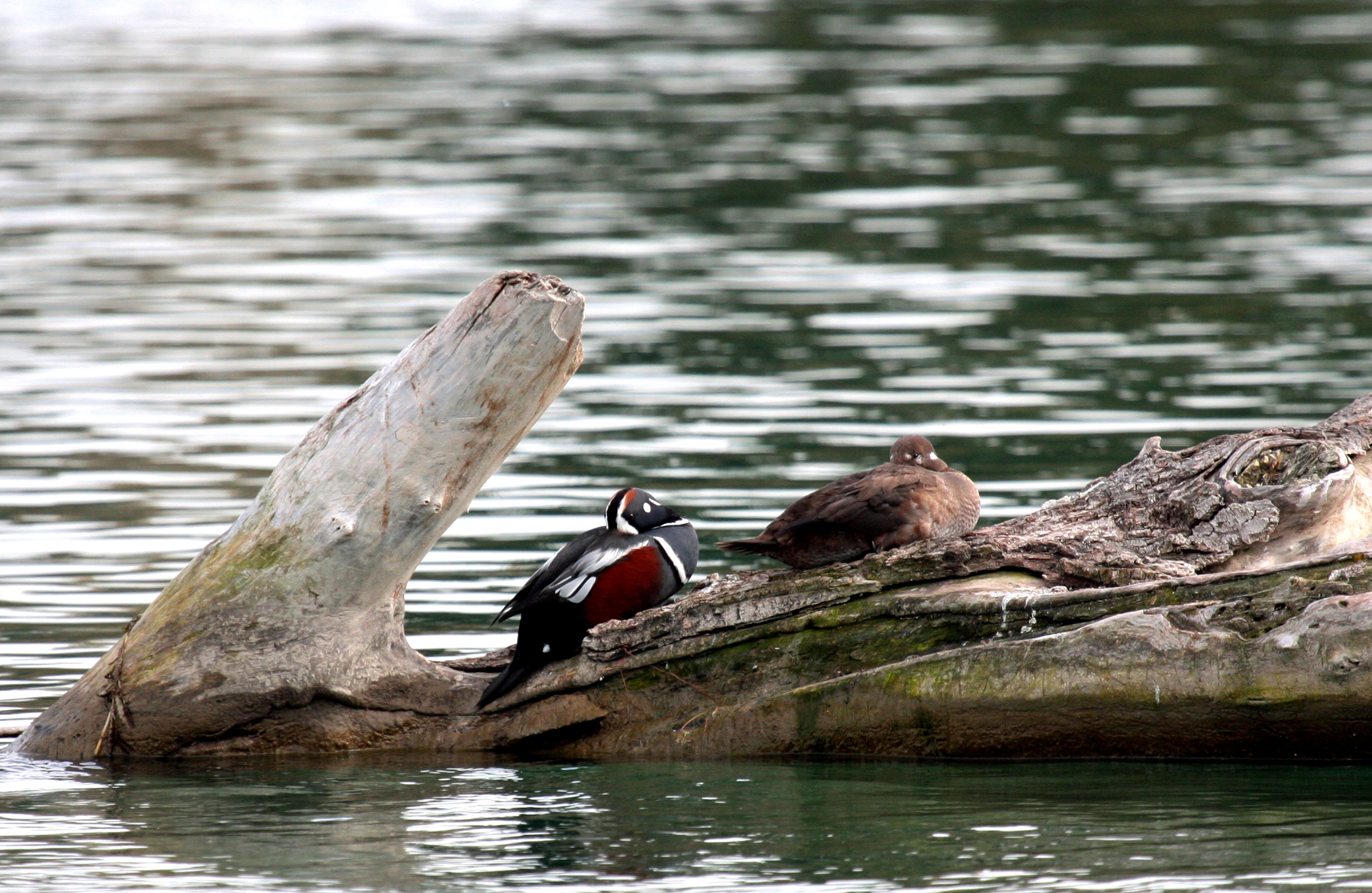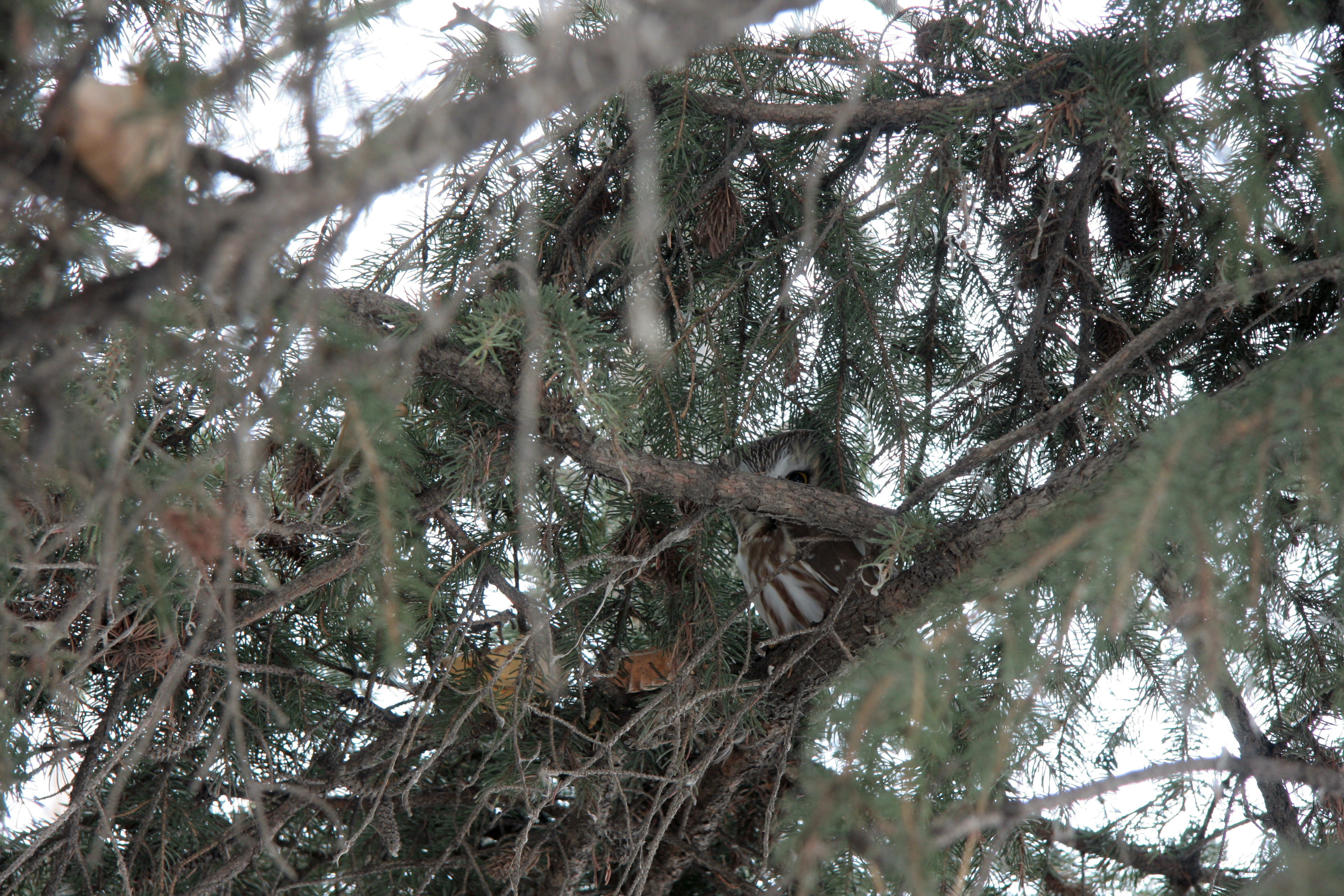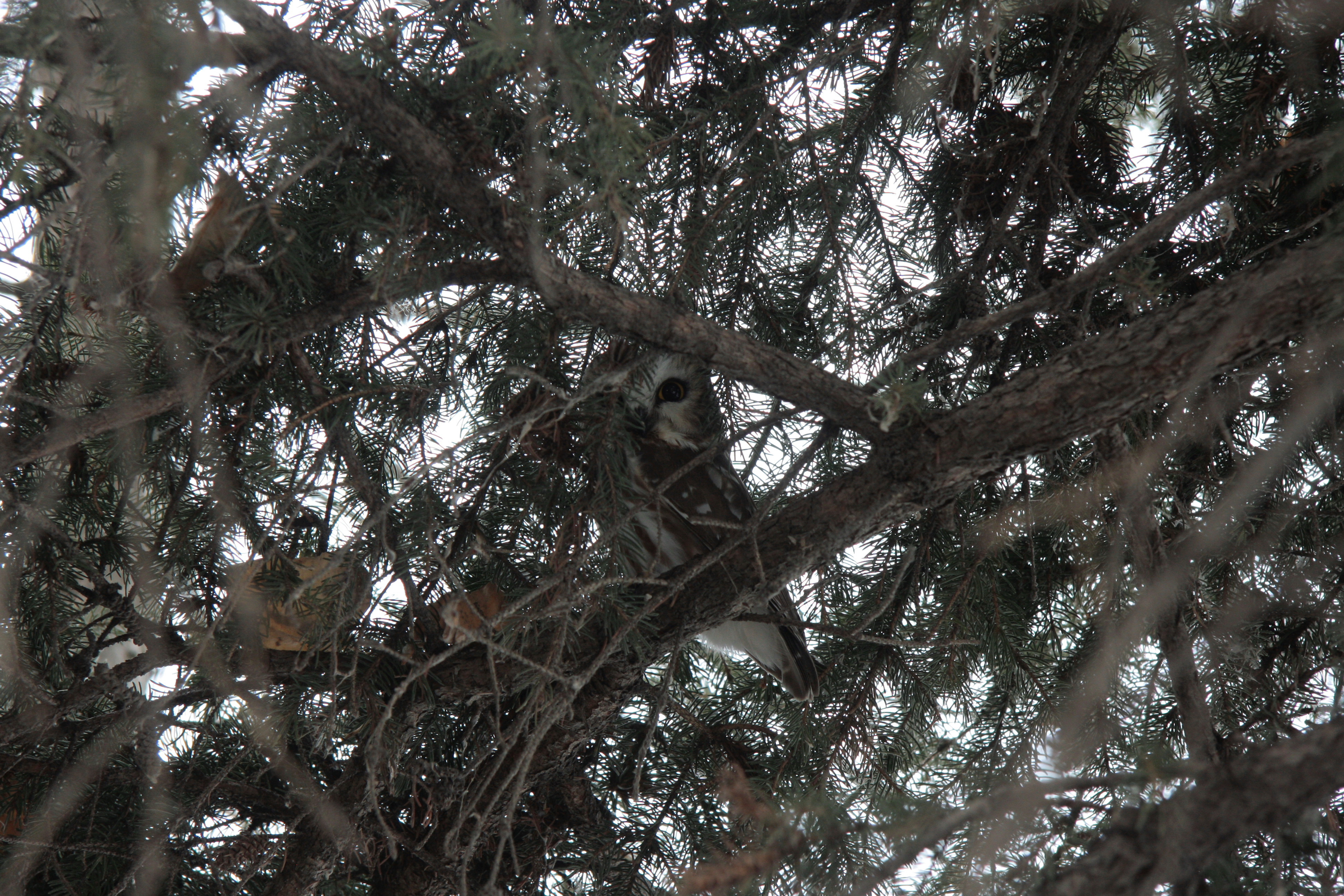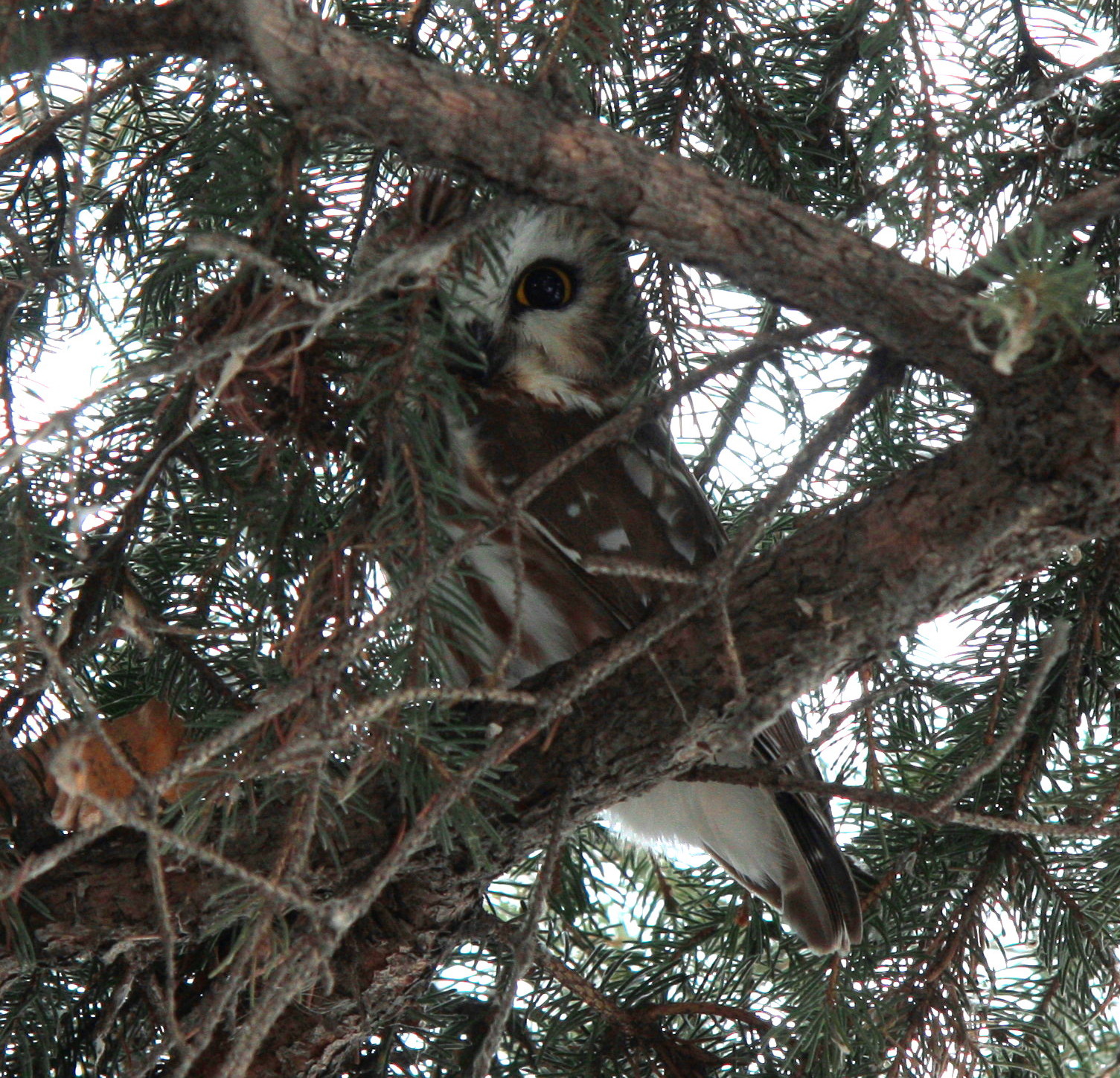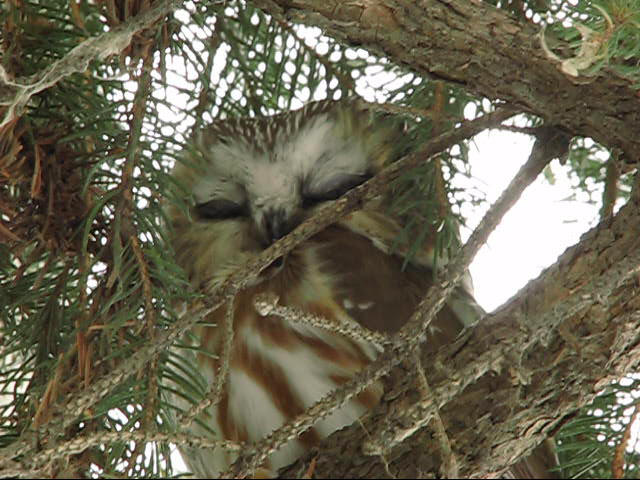(Note: The Elbow River Bird Survey is a Nature Calgary field trip. Like all of Nature Calgary’s field trips, it is free, and anyone can participate – you don’t have to be a member. Meet in the parking lot at Stanley Park on 42 Avenue SW, just west of Macleod Trail, at 8:30 am. If you would like to join us, call Gus or Aileen at 403-243-2248.)
When I began to bird seriously, I found that the fastest way to learn was to go on field trips offered by Nature Calgary (also known as the Calgary Field Naturalists’ Society). The best way to see a lot of bird species and learn to identify them is to go out in the company of experienced birders.
One of my favourite field trips is the Elbow River Bird Survey. This is a walk along the Elbow from Stanley Park to the Glenmore Dam. It has been led on the first day of each month for over fifteen years by Gus Yaki and his wife, Aileen Pelzer. The walk starts shortly after dawn and takes about three and a half hours.
Wood Ducks perched beside the river, March 1, 2008.
A Common Merganser on the River near Stanley Park, November 1, 2009.
Gus is a lifelong naturalist and is very informative about birds, plants, and other natural history. He keeps track of all the bird and mammal species seen, and the numbers of each. He is gathering valuable data on the changes in bird populations along the river.
Gus Yaki (pointing) leading a walk on the Elbow River pathway, November 1, 2009.
The walk is mostly flat and easy, with one small hill between Sandy Beach and the Glenmore dam. There are a variety of habitats on the walk. You can see waterfowl on the river and the reservoir, songbirds in the parks and along the tree-lined urban streets and backyards, woodpeckers in the stand of old poplars in Riverdale Park, and the occasional raptor almost anywhere. In recent years Gus has been posting the list of species seen each month on the Albertabird Listserv. You always see something interesting.
This Northern Goshawk had just knocked a Common Goldeneye down onto the ice on the river. It flew off without pursuing the attack. February 1, 2009.
Like all of Nature Calgary’s field trips, this walk is free and open to everyone. You do not have to be a member of Nature Calgary to participate. If you plan to attend, since this is a one-way walk, call Gus and Aileen ahead of time, so they can arrange to carpool us back to the starting point. The starting time changes throughout the year so check the field trip list on the Nature Calgary website or on the Calgary Rare Bird Alert (RBA) on Albertabird.
To participate, meet in the parking lot at Stanley Park on 42 Avenue SW, just west of Macleod Trail at 8:30 am. If you would like to join us, call Gus or Aileen at 403-243-2248.
The Elbow River with the Glenmore Dam in the Backgound.
The Elbow River between Glenmore Dam and Sandy Beach.
Downstream from Sandy Beach.
Some Recent Results of the Elbow River Bird Survey:
Wednesday, December 1, 2010. Sunny, calm, -02 to 02C.
- Canada Goose-262
- Mallard-60
- Common Goldeneye-1f
- Rock Pigeon-2
- Downy Woodpecker-2
- Hairy Woodpecker-1
- Northern Flicker-1
- Black-billed Magpie-31
- Common Raven-5
- Black-capped Chickadee-22
- Red-breasted Nuthatch-1
- White-breasted Nuthatch-3
- Townsend’s Solitaire-2
- American Robin-2
- Eur. Starling-4
- Bohemian Waxwing-60
- Dark-eyed Junco-1
- House Finch-1
- House Sparrow-12
(Eastern Gray Squirrel – 6 )
November 1, 2010, 9:20-11:50am. Partly cloudy, calm –1 to 6 C.
- Canada Goose-5
- Wood Duck-2
- Mallard-50
- Hooded Merganser-3
- Bald Eagle-1
- Rough-legged Hawk-1
- Ring-billed Gull-20
- Rock Dove-3
- Downy Woodpecker-4
- Northern Flicker-3
- Blue Jay-2
- Black-billed Magpie-52
- American Crow-1
- Common Raven-3
- Black-capped Chickadee-22
- Red-breasted Nuthatch-3
- White-breasted Nuthatch-1
- American Robin-4
- European Starling-13
- House Finch-7
- House Sparrow-15
October 1, 2010. Mostly sunny, becoming windy, 20kph, 02-10C.
- Canada Goose-60
- Wood Duck-3
- Mallard-2
- Osprey-1
- Bald Eagle-1 ad/1 imm.
- Harlan’s Hawk, light morph-1, chased by 20 starlings, then harassed by 25 B.b. Magpies.
- Merlin-1
- Ring-billled Gull-4
- Rock Pigeon-4
- Northern Flicker-10
- Blue Jay-1+
- Black-billed Magpie-60
- American Crow-24
- Common Raven-1
- Black-capped Chickadee-16
- Red-breasted Nuthatch-6
- White-breasted Nuthatch-2
- American Robin-70
- European Starling-30
- Yellow-rumped Warbler-1
- House Sparrow-7
- Eastern Gray Squirrel-9
- Red Squirrel-1
September 1, 2010. Mostly cloudy, NW wind 20kph, 7-12C.
- Canada Goose-2
- Wood Duck-4
- Mallard-17
- Common Merganser-3
- Red-necked Grebe-1
- Osprey-2
- Bald Eagle-1 imm.
- Sharp-shinned Hawk-1
- Cooper’s Hawk-1
- Merlin-1, repeatedly diving at Northern Flickers.
- Ring-billed Gull-1+
- California Gull-60
- Rock Pigeon-1
- Northern Flicker-12
- Western Wood-Pewee-1
- Red-eyed Vireo-1
- Blue Jay-3
- Black-billed Magpie-25
- Am. Crow-44
- Common Raven-4
- Black-capped Chickadee-1, unusually low number.
- Red-breasted Nuthatch-3
- American Robin-40
- Gray Catbird-1
- European Starling-5
- Cedar Waxwing-40
- Yellow-rumped Warbler-2 imm.
- Wilson’s Warbler-11
- Clay-colored Sparrow-1+
- House Finch-3
- Pine Siskin-20
- Am. Goldfinch-1 m.
(Amazingly, first time without a House Sparrow).
Eastern Gray Squirrel-1
Mule Deer-1
August 1, 2010, 0700-1045. Heavy overcast, light drizzle, 14-15C. 7 observers.
1.. Mallard-25
2.. Common Merganser-11
3.. Common Loon-2
4.. Osprey-1
5.. Merlin-1
6.. California Gull-41
7.. Rock Pigeon-25
8.. Downy Woodpecker-3
9.. Northern Flicker-18
10.. Western Wood-Pewee-3
11.. Least Flycatcher-1
12.. Black-billed Magpie-46
13.. American Crow-23
14.. Common Raven-5
15.. Tree Swallow-8
16.. Cliff Swallow-500
17.. Black-capped Chickadee-3
18.. Red-breasted Nuthatch-4
19.. House Wren-6
20.. American Robin-48
21.. Gray Catbird-5
22.. Cedar Waxwing-30
23.. Yellow Warbler-3
24.. Western Tanager-3, all 3 at different sites.
25.. Chipping Sparrow-6
26.. Clay-colored Sparrow-1
27.. Song Sparrow-1
28.. Brown-headed Cowbird-1
29.. Baltimore Oriole-1 juv. m.
30.. House Finch-15
31.. American Goldfinch-1 m.
32.. House Sparrow-60.
Also seen, amidst dense leaves at the Glenmore Dam, was a warbler head with a
gray face, eye-ring, light throat and with a yellow wash, apparently on the
upper chest. The first impression was that of a female American Redstart, but
the yellow was definitely on the chest, not on the flanks. At no time was any of
the rest of the body seen. The only other choice was a Virginia’s Warbler. Both
species of course are unlikely at this time. A birding mystery.
Eastern Gray Squirrel-1
Least Chipmunk.
July 1, 2010, 0630-11am, Stanley Park-Glenmore Dam.
1.. Canada Goose-51
2.. American Wigeon-1 m.
3.. Mallard-7 + young.
4.. Common Goldeneye-2 f.
5.. Common Merganser-3 f.
6.. Osprey-1 on nest
7.. Swainson’s Hawk-1
8.. Red-tailed Hawk-1+
9.. Rock Pigeon-5
10.. Downy Woodpecker-2
11.. Northern Flicker-9
12.. Least Flycatcher-3
13.. Red-eyed Vireo-1
14.. Black-billed Magpier-46
15.. American Crow-11
16.. Tree Swallow-10+
17.. Bank Swallow-3
18.. Cliff Swallow-20+
19.. Black-capped Chickadee-5
20.. Red-breasted Nuthatch-1
21.. House Wren-6
22.. American Robin-32
23.. Gray Catbird-4
24.. European Starling-14
25.. Cedar Waxwing-15
26.. Yellow Warbler-12
27.. Clay-colored Sparrow-4
28.. Song Sparrow-1
29.. Lincoln’s Sparrow-1
30.. White-throated Sparrow-1
31.. Brown-headed Cowbird-3
32.. House Finch-10
33.. House Sparrow-10
Eastern Gray Squirrel-12
June 1, 2010, 0640-1100. Mostly cloudy, S wind 10kph, 5-12C.
a.. Canada Goose-34 + 15 yg/
b.. Mallard-15 m
c.. Common Goldeneye-2 f
d.. Common Merganser-1 f
e.. Osprey-1
f.. Red-tailed Hawk-1+
g.. Spotted Sandpiper-2
h.. Franklin’s Gull-10
i.. Rock Pigeon-14
j.. Downy Woodpecker-2
k.. Northern Flicker-10
l.. ?Western Wood-Pewee-1
m.. Black-billed Magpie-23
n.. Am. Crow-4
o.. Tree Swallow-36+
p.. Bank Swallow-1
q.. Cliff Swallow-20+
r.. Black-capped Chickadee-16
s.. Red-breasted Nuthatch-4
t.. House Wren-5+
u.. Swainson’s Thrush-1
v.. Am. Robin-36
w.. Gray Catbird-4+
x.. European Starling-20
y.. Yellow Warbler-16+
z.. Chipping Sparrow-5
aa.. Clay-colored Sparrow-8+
ab.. Song Sparrow-1 heard
ac.. Common Grackle-2
ad.. Brown-headed Cowbird-6+
ae.. House Finch-3
af.. House Sparrow-14
a.. Eastern Gray Squirrel-7
b.. Red Squirrel-1
Saturday May 1, 2010 0700-1200. Mostly sunny, calm, 0-10C.
- Canada Goose-15, with three clutches of 5, 5, and 3 young.
- Wood Duck-3 m.
- Mallard-20
- Bufflehead-10
- Common Merganser-6
- Ring-necked Pheasant-4 m
- Common Loon-1
- Horned Grebe-4
- Red-necked Grebe-1
- Cooper’s Hawk-1
- Red-tailed Hawk-1
- Merlin-2
- Rock Pigeon-8
- Franklin’s Gull-60+
- white-headed gulls, high in flight-10+
- Yellow-bellied? Sapsucker-3
- Downy Woodpecker-8
- Hairy Woodpecker-1
- Northern Flicker-10
- Blue Jay-1
- Black-billed Magpie-26
- American Crow-10+
- Tree Swallow-3
- Northern Rough-winged Swallow-6, over river, seen by Aileen.
- Black-capped Chickadee-35
- Red-breasted Nuthatch-10
- White-breasted Nuthatch-1 hear
- American Robin-60
- European Starling-12
- YELLOW-RUMPED WARBLER-2
- Song Sparrow-1
- BROWN-HEADED COWBIRD-1
- House Finch-12+
- Pine Siskin-3
- House Sparrow-10
Eastern Gray Squirrel-6
Wednesday March 31, 2010 (for April), Partly cloudy, calm,
0-8C. Ice at Reservoir Dam still frozen.
1.. Canada Goose-16
2.. Mallard-20
3.. Common Merganser-2
4.. Ring-billed Gull-12
5.. Rock Pigeon-6
6.. Downy Woodpecker-8
7.. Northern Flicker-6
8.. Blue Jay-1
9.. Black-billed Magpie-16
10.. American Crow-4
11.. Common Raven-8
12.. Black-capped Chickadee-12
13.. Red-breasted Nuthatch-5
14.. American Robin-36
15.. European Starling-6
16.. House Finch-10
17.. Pine Siskin-1
18.. House Sparrow-6
Eastern Gray Squirrel-2
Monday March 1, 2010, 8:00-12:30. Sunny, calm, -4 to 9C.
- Canada Goose-140
- Wood Duck-1 pr.
- Mallard-60
- Common Goldeneye-1 m.
- Common Merganser-4
- Merlin-1 carrying prey.
- Rock Pigeon-5
- Great Horned Owl-2
- Downy Woodpecker-8
- Hairy Woodpecker-5
- Northern Flicker-6+
- Blue Jay-1+ heard.
- Black-billed Magpier-30
- Common Raven-3
- Black-capped Chickadee-22
- Red-breasted Nuthatch-5
- White-breasted Nuthatch-3
- Brown Creeper-2
- European Starling-5
- House Finch-6+
- Pine Siskin-2+
- House Sparrow-16
Eastern Gray Squirrel-6
Monday, February 1, 2010, 0815-1145. Sunny, Calm, -6 to -2C.
1.. Canada Goose-190
2.. Mallard-160
3.. Common Goldeneye-2
4.. Common Merganser-2
5.. Bald Eagle-1 ad.
6.. Rock Pigeon-4
7.. Downy Woodpecker-4
8.. Hairy Woodpecker-1
9.. Northern Flicker-2
10.. Black-billed Magpie-45
11.. Common Raven-9
12.. Black-capped Chickadee-62, counted by Tony T.
13.. Red-breasted Nuthatch-1
14.. White-breasted Nuthatch-1
15.. European Starling-8
16.. Bohemian Waxwing-350
17.. House Finch-6
18.. House Sparrow-24
Eastern Gray Squirrel-4
Saturday January 3, 2010: 8:30-12noon, Sunny, calm, -12C. 7 participants
1.. Canada Goose-450
2.. Mallard 500
3.. Common Goldeneye-8
4.. Common Merganser-2
5.. Downy Woodpecker-7
6.. Hairy Woodpecker-2
7.. Black-billed Magpie-60
8.. Common Raven-14
9.. Black-capped Chickadee-32
10.. Red-breasted Nuthatch-7
11.. White-breasted Nuthatch-1
12.. Bohemian Waxwing-200
13.. House Finch-1
14.. Common Redpoll?-5
15.. House Sparrow-35
a.. Eastern Gray Squirrel-7
b.. White-tailed Jackrabbit-tracks.
c.. Coyote tracks
Posted by Bob Lefebvre
.
- Canada Goose-262
- Mallard-60
- Common Goldeneye-1f
- Rock Pigeon-2
- Downy Woodpecker-2
- Hairy Woodpecker-1
- Northern Flicker-1
- Black-billed Magpie-31
- Common Raven-5
- Black-capped Chickadee-22
- Red-breasted Nuthatch-1
- White-breasted Nuthatch-3
- Townsend’s Solitaire-2
- American Robin-2
- Eur. Starling-4
- Bohemian Waxwing-60
- Dark-eyed Junco-1
- House Finch-1
- House Sparrow-12
Eastern Gray Squirrel – 5
